|
Undated Photo Of Jack Clemens Hodgson, Probably Ca. 1924,
After He Received His Wings (Source: Hodgson Family via Woodling)
 |
Jack Hodgson landed at Tucson five times as a lieutenant during 1926 and 1927. As such, he was a relatively frequent military visitor, achieving about the same landing average as, say, Ira Eaker who landed 16 times over six years. Hodgson was based at San Antonio, TX, Brooks Field during each of his visits.
We are fortunate to have a number of photographs and documents related to Hodgson and his life near the time he visited us at Tucson. They come to us from his son, Jack N. Hodgson (cited, right sidebar) via site Guest Editor Bob Woodling. The images comprise formal portraits and informal snapshots of Hodgson and his aircraft. The documents include the pages of his flight logs that place him at Tucson five times. Below, the cover from that log.
Jack C. Hodgson’s Second Logbook, Beginning In June, 1925 (Source: Hodgson Family via Woodling)
 |
His name, and the sketch of the airplane on the log cover, appear to be added personalizations of his book. Compare it to his other book cover, below.
His first two landings, on Monday, August 16th and Wednesday, August 25, 1926, were in the deHavilland DH-M2, 23-177. His log pages cite the make of his aircraft, but not the model or registration number.
Both landings he carried as passenger a Sgt. Gershon. They appeared to be on a two-week round trip from San Antonio to San Francisco, CA. They gave no purpose for their trip. Below, courtesy of Hodgson's son, is an image of pilot Hodgson's log book on the day he landed first at Tucson. Note his mention of passenger Gershon. This was Hodgson's second log book.
Lt. Hodgson’s First Visit To Tucson, August 16, 1926, Arriving From Deming, NM And Departing For San Diego (Source: Hodgson Family via Woodling)
 |
Their itinerary after they left Tucson was northbound along the Pacific coast to San Francisco (Crissy Field).
The next page of his log, below, records their second landing at Tucson. Interestingly, Hodgson recorded the number of "hops," and all this travel from Tucson and return was done in single hops between stations. Some of his hops exceeded four hours, a long time to fly in an open cockpit DH.
Hodgson’s Second Visit To Tucson Was On The Return Trip From California, Landing On August 25, 1926 And Departing On August 26 For El Paso (Source: Hodgson Family via Woodling)
 |
For the time, Hodgson was an experienced pilot, having logged over 1,400 hours of flight time before his landings at Tucson. This summary page, below, that appears at the beginning of the same log, tallies over 600 hours' flight experience from his first log. He had flown at least ten types and twelve different models of aircraft. Most of his time was spent in the deHavilland.
Inside Front Page Of Logbook Number 2, Showing Hours Accumulated In Logbook 1 (Source: Hodgson Family via Woodling)
 |
Hodgson's third signature in the Register was on Friday, April 29, 1927 at 4:00PM. He was solo in the Douglas C-1 transport, 27-210. He remained overnight at Tucson, departing the next morning at 6:00. He was eastbound from San Diego, CA to San Antonio on what he termed a "Ferry" in the remarks column of the Register. The two log pages documenting his visit and departure are below.
Hodgson’s Third Visit To Tucson Involved An Overnight Stay In Tucson (Source: Hodgson Family via Woodling)
 |
Note on the page above that he provided dual instruction to Register pilot and General Frank P. Lahm on April 1, 5 and 15.
Hodgson’s Third Visit To Tucson Involved An Overnight Stay In Tucson (Source: Hodgson Family via Woodling)
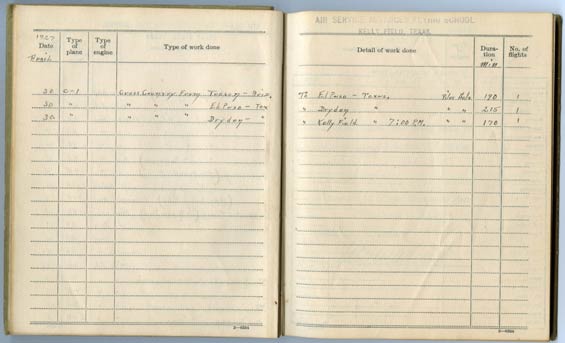 |
His fourth and fifth landings were in two different aircraft. His visits were part of a long cross-country flight from Kelly Field to Spokane, WA for the 1927 National Air Races. His passenger was General Lahm, the air corps officer in charge of training. They landed westbound on Thursday, September 8, 1927 flying 25-385 (a Douglas O-2) and again on Thursday September 29, 1927 flying the same airplane. Their journey was a three-week trip. Below, the pages from his pilot log that document their landings at Tucson and their flights in between.
Log of Hodgson’s Fourth Visit (Source: Hodgson Family via Woodling)
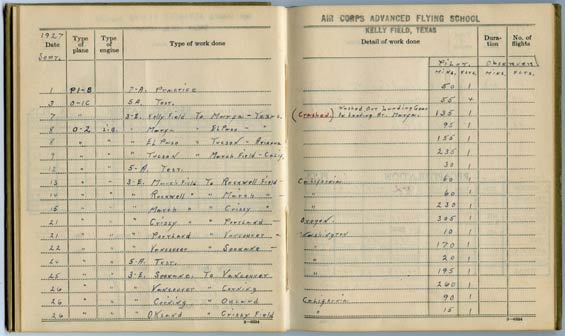 |
Upon his homeward-bound landing, Hodgson noted in the remarks column of the Register, "It won't be long now."
Log of Hodgson’s Fifth Visit (Source: Hodgson Family via Woodling)
 |
Interestingly, between Hodgson's 4th and 5th landings, we find Charles Lindbergh signing the same Register page On September 27th during his U.S. Tour after his trans-Atlantic flight.
From the Air Force Register, 1953, we learn that Hodgson was first paid by the Army on October 9, 1917. Hodgson rose through the ranks, from ordinary private to full colonel circa February 1, 1942. Below, from the cryptic Official Army and Air Force Register dated January 6, 1948, is his full career through that date. We learn that he transferred from the regular Army to the Air Service on October 19, 1925.
Jack C. Hodgson, Army and Air Force Register, January 6, 1948 (Source: Woodling)
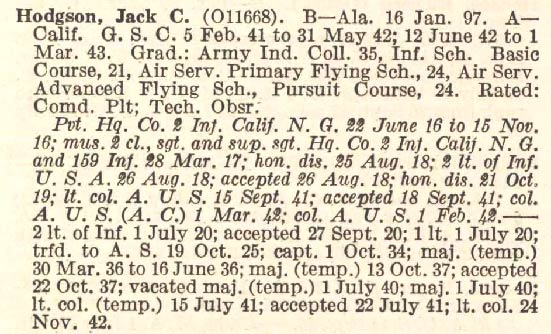 |
After his visits at Tucson, according to the Syracuse (NY) Herald of August 30, 1931, below, then lieutenant Hodgson was assigned for three years to help build the Cuban Air Force. Hodgson is pictured at the numeral "1" in the left-hand photograph.
Syracuse (NY) Herald, August 30, 1931 (Source: Woodling)
 |
Courtesy of his son, we have representative pages from Hodgson's pilot log book of the period. The cover is below. A significant part of this book covers his flights in Cuba, where he was sent in 1928 to help the Cubans build and air force. “Primer teniente” means “first lieutenant.”
Front Cover Of Hodgson’s Third Log Book (Source: Hodgson Family via Woodling)
 |
Below, a sample page from the third logbook, dated August 1928. Hodgson was based at Camp Columbia, Havana, Cuba, and was providing flight instruction to Cuban pilots. "Prueba de la mácquina" means "test of the machine:" a flight test.
Page From Third Logbook, Cuba, August 1928 (Source: Hodgson Family via Woodling)
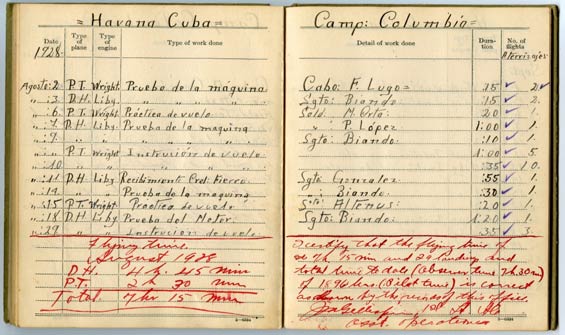 |
After his return to the U.S. from Cuba, he commanded the 36th Fighter Squadron July 13, 1931-June 4, 1932 when it was based at Selfridge Field, MI. According to the Army and Air Force Register, he was promoted to captain in 1934, and to major in 1937. In 1937, he was appointed air attaché to Rome. Below, a photograph of him during that time. Note the U.S. and Italian flags on the vertical tail.
Undated Photo Of Jack C. Hodgson Ca. 1937-1940. The Airplane Is A Consolidated PT-11 or PT-12 That Was Used By Jack During His Tour Of Duty At The US Embassy In Rome (Source: Hodgson Family via Woodling)
![Undated Photo Of Jack C. Hodgson Ca. 1937-1940. The Airplane Is A Consolidated PT-11 Or PT-12 [Does Anyone Know?] That Was Used By Jack During His Tour Of Duty At The US Embassy In Rome (Source: Hodgson Family via Woodling)](/people/hodgson_jc/images/Ca_1937-1940Hodgson.jpg) |
1937 Newspaper Article Describing Capt. Hodgson’s Appointment As Air Attaché In Rome (Source: Hodgson Family via Woodling)
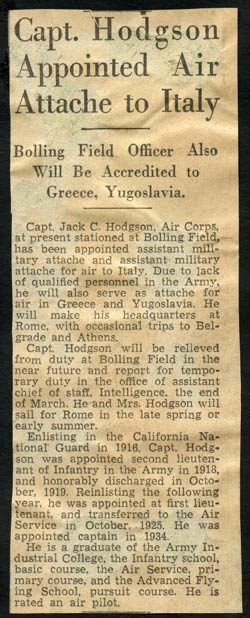 |
At right, an unsourced newspaper article from 1937 that documents Hodgson's appointment to Rome. He had responsibility for Greece and Yugoslavia as well, because of, "... lack of qualified personnel in the Army...." The article mentions his wife.
Below, Mrs. Jack C. Hodgson, the former Natalie St. Clair Norwood, daughter of Mr. and Mrs. Guy Norwood of Washington, DC. The Hodgsons were married in the chapel at West Point.
Mrs. Jack C. Hodgson, The Former Natalie St. Clair Norwood, Date Unknown (Source: Hodgson Family via Woodling)
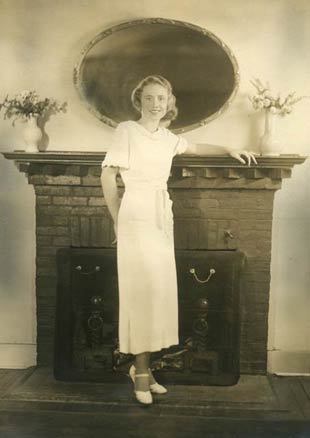 |
Hodgson was attached to the U.S. Embassy in Rome from 1937 to 1940. Below is an undated photo, ca. 1939, of Jack Hodgson (left) and unknown Italian officer. The airplane is most likely the Beech YC-43, serial number 39-141, one of the three airplanes of the type that were allocated to U.S. Embassies in London, Paris and Rome. This was a rare airplane. One of the three YC-43s has been fully restored and is in flying condition. See it at the link.
Undated Photo, Ca. 1939, Of Jack Hodgson And Unknown Italian Officer (Source: Hodgson Family via Woodling)
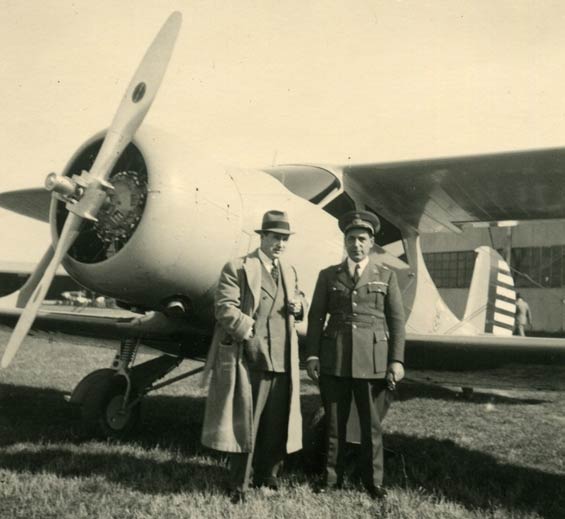 |
Hodgson’s Calling Card While Stationed In Rome (Source: Hodgson Family via Woodling)
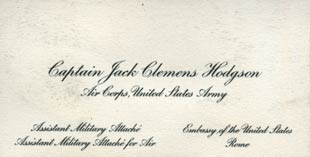 |
At left is Hodgson's calling card when he was based in Rome at the United States Embassy.
As WWII approached its end, on February, 1944 Hodgson took command of the U.S. Army Air Forces in Canada. He had been promoted to Lt. Col. in 1942. The following letter, under his own hand as a colonel, dated February 12th, authorizes the command.
Jack C. Hodgson, Command Letter, February 12, 1944 (Source: Web)
 |
Below are two photographs dated just before he and his family departed for Canada. The first undated photo, taken ca.1943, at Cochran Field, Macon, GA, shows L-R: 5-year old Jack N. Hodgson, Mrs. Hodgson, Colonel Hodgson, unidentified major general, unidentified major.
Undated Photo Ca.1943 Taken At Cochran Field, Macon, GA (Source: Hodgson Family via Woodling)
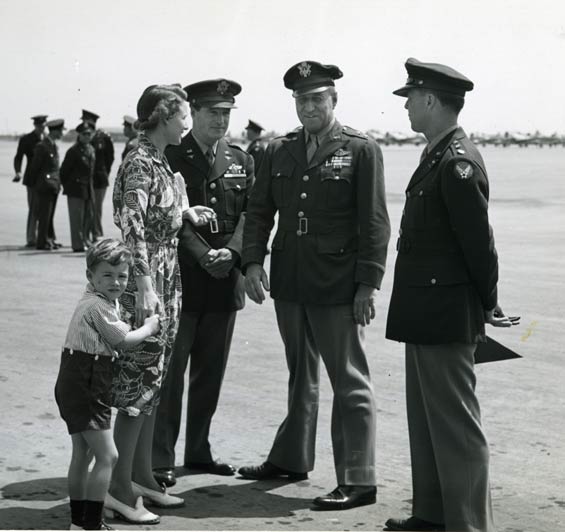 |
Below, photo taken early 1944 At Cochran Field, Macon, GA, showing the family’s departure for Colonel Hodgson’s new assignment in Canada. (Colonel Hodgson left front, Mrs. Hodgson and Jack N. Hodgson on the right.)
Ca. Early 1944 At Cochran Field, Macon, GA (Source: Hodgson Family via Woodling)
 |
Below, left, Colonel Jack C. Hodgson during the time that he was commander of the US Army Forces in Central Canada. Winnipeg, Manitoba, 1944-1945.
Colonel Jack C. Hodgson During The Time That He Was Commander Of The US Army Forces In Central Canada. Winnipeg, Manitoba, 1944-1945 (Source: Hodgson Family via Woodling)
 |
After the war, although the dates aren't clear, according to the Windsor (Ontario) Daily Star of Friday, October 4, 1946, Hodgson was commander of an offensive entity called the "Crimson Route," an air route with landing fields and radio navigation aids built across Canada to facilitate movement of war supplies to Europe via Greenland and Iceland in the event sea-borne supplies were cut off by enemy action. They never were and the Crimson Route was not used to any great extent. American garrisons never participated in cold weather exercises, but found time to make suggestions to Washington for improvements to clothing and other cold weather gear. The Daily Star states, "Col. Hodgson, for instance, suggested an important alteration in the service parka which provided more protection against the sharp climate."
Further to the Crimson Route, the following is quoted from the Canada Chief of Military History source cited in the left sidebar. "The Second World War was a watershed in the militarization of the Canadian North. At the behest of American military planners interested in securing reliable access to Alaska, Canadian officials agreed to support the construction of northern airfields. The Northwest Airway, built from 1939-1941 to link Edmonton to Fairbanks, established airfields and radio sites at one hundred mile intervals.
Undated Photo Of Colonel Hodgson While Posted at Cochran Field, Macon Georgia, During WWII (Source: Hodgson Family via Woodling)
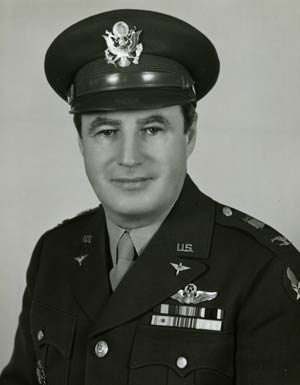 |
"The subsequent Northwest Staging Route produced a larger series of airfields in the Yukon and provincial norths, as did highway and oil projects. In the eastern Arctic, the Crimson Route consisted of airbases built to ferry aircraft and supplies to Europe. These were constructed in Goose Bay, Fort Chimo, and Frobisher Bay in 1941, and at The Pas, Churchill, and Southampton Island the following year. Even when these facilities were not used as planned, they opened up new transportation routes to-and through-the North. None were large or paved, with the exception of Goose Bay, Labrador, which boasted the world's largest airport by 1943.
"Besieged by a 'friendly invasion' of Canadian and American soldiers, airmen and seamen, Newfoundland and Labrador was particularly affected by the reach of World War II; the social and environmental traces of this are still discernable today, from Argentia to Gander and beyond. In Goose Bay, the presence of an airport was a boon, at least for non-Aboriginal residents. Its creation displaced a settlement of about thirty Native families, however, and provided few jobs for Native peoples once construction finished."
About a month after the end of WWII, a farewell banquet was held in Hodgson's honor. With the banquet, he relinquished his U.S. Army command in Central Canada. His banquet was held at Winnipeg, September 15, 1945. The program for the banquet for Hodgson and his staff is below.
Program For Farewell Banquet In Honor Of Hodgson And His Staff Of The US Army Command In Central Canada. Winnipeg, September 15, 1945 (Source: Hodgson Family via Woodling)
 |
The Fort Garry Hotel still exists at 222 Broadway in Winnipeg. Rooms are from $139 Canadian as of the upload date of this page. I could find no mention made of the Jade Room on the hotel's Web site.
Program For Farewell Banquet In Honor Of Hodgson And His Staff Of The US Army Command In Central Canada. Winnipeg, September 15, 1945 (Source: Hodgson Family via Woodling)
 |
Room 202 of the hotel is reported to be haunted, if you believe in such things.
Program For Farewell Banquet In Honor Of Hodgson And His Staff Of The US Army Command In Central Canada. Winnipeg, September 15, 1945 (Source: Hodgson Family via Woodling)
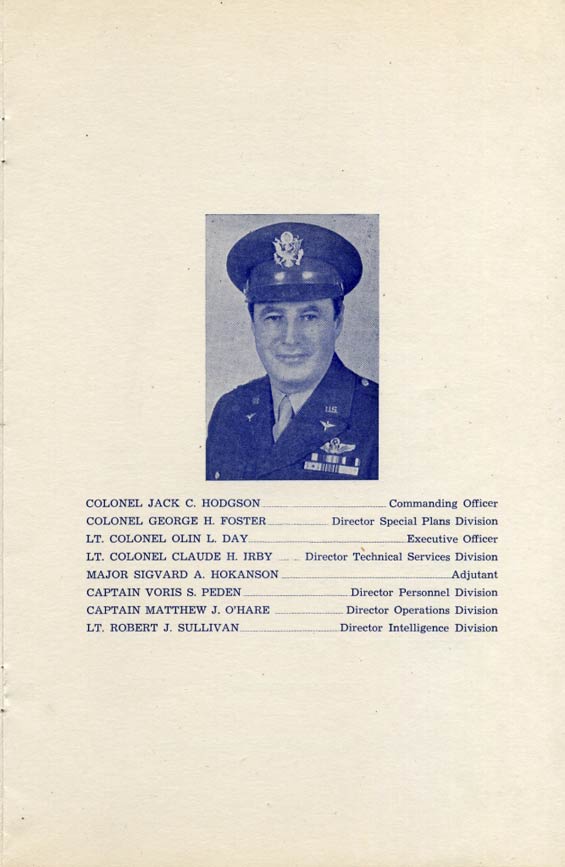 |
Below, Hodgson receives the Legion of Merit.
Colonel Jack C. Hodgson Receiving The Legion Of Merit Decoration From Lt. General Charles P. Hall, Ca. 1946 (Source: Hodgson Family via Woodling)
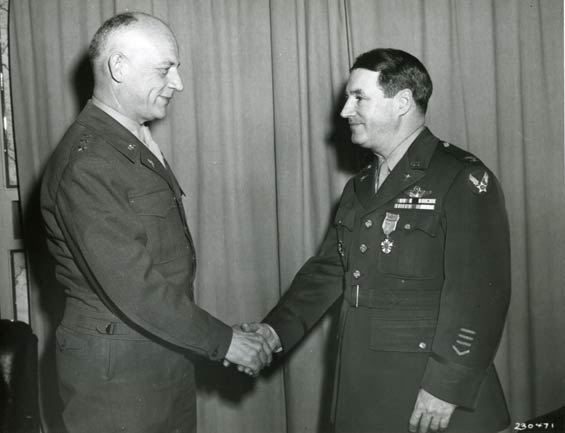 |
Hodgson remained in Canada after the war. The Foreign Service Lists for July 28,1948 and for January 1, 1950 cite Hodgson, still a colonel, as Senior Military Attache and Air Attache in Canada.
Below, Hodgson at his desk. The back of photo has the words “Official U.S. Navy photo” and the location is New York City. His son does not know any more details, other than they were posted to Governor’s Island at some time after WWII.
Jack C. Hodgson, New York City, Date Unknown (Source: Hodgson Family via Woodling)
 |
In the 1950s, he commanded the ROTC organization at Dartmouth College. Below, two articles from the Springfield (MA) Union describing his activites with the ROTC.
Hodgson & Dartmouth ROTC, September 18, 1951 (Source: Woodling)
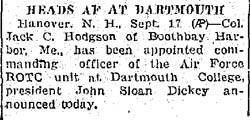 |
Hodgson & Dartmouth ROTC, January 4, 1952 (Source: Woodling)
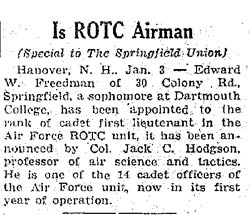 |
Hodgson was born January 16, 1897 and died in 1979 in his early 80s. Below, Hodgson's obituary from The Seattle Times, January 10, 1979.
Jack C. Hodgson, Obituary, The Seattle Times, January 10, 1979 (Source: Woodling)
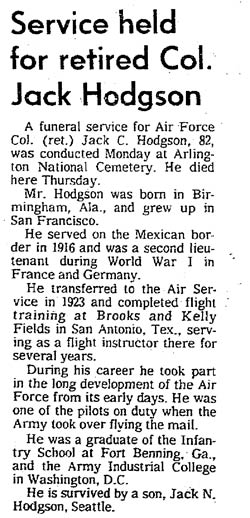 |
Colonel Hodgson’s Son, Jack N. Hodgson, Holding A Framed Photo Of His Father With An Airplane That Was Attached To The US Embassy In Rome. Photo Taken At Medina, WA, August 14, 2012 (Source: Woodling)
 |
At right, our benefactor of this page holding the photograph of his father exhibited above.
Hodgson's Web presence is sparse at best, with just a few news articles and other items as cited above. If you can help fill in his history, please let me KNOW.
---o0o---
THIS PAGE UPLOADED: 01/09/12 REVISED: 08/21/12
|















![Undated Photo Of Jack C. Hodgson Ca. 1937-1940. The Airplane Is A Consolidated PT-11 Or PT-12 [Does Anyone Know?] That Was Used By Jack During His Tour Of Duty At The US Embassy In Rome (Source: Hodgson Family via Woodling)](/people/hodgson_jc/images/Ca_1937-1940Hodgson.jpg)

















